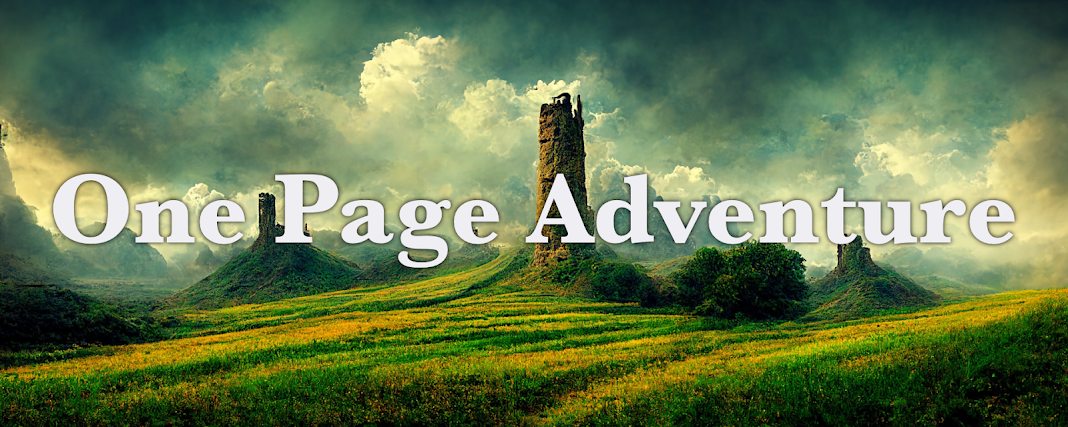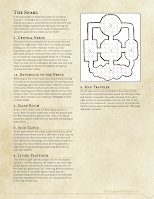2018 Layout Process
When I first started writing adventures I didn't have much in the way of technical ability for layout and design. I knew I wanted everything to use a one page layout after seeing entries for the
one page dungeon contest. The benefits of not having to flip through multiple pages while running a game were obvious and the down side of not being able to have larger form content seemed unimportant.
Formatting Tools
LaTeX
I had some experience with using
LaTeX for resumes and most of the online tools for making dnd content where still very new so it seemed like the best choice at the time. LaTeX did a good enough job but was difficult to use requiring a specific program to run, a lot of specific formatting, and was in general fairly slow to make content with. The tool was good enough to output a lot of content and I played with different page size formats and printing options but ultimately ease of use just wasn't there.
Google Docs
The next tool I attempted to use was google docs which checked the boxes I wanted for ease of use. I could fairly easily write and edit adventures from any device I owned and didn't need to install any special tools to do so. While it could handle basic adventure structures it quickly became apparent that if I wanted anything more advanced like tables, stat blocks, or visually appealing headers/footers I would need to look for something else.
Homebrewery
The current tool I am using is
homebrewery mixed with a google docs for first drafts and planning. It is browser based and can be used from most of the devices I have. It has built in formatting with a lot of visual appeal which lets me spend more time writing and less time messing with formatting which is a huge help. It has a little bit of a learning curve but overall it has been easy to learn how to use and customize to what I want.
Art
Making art has been a constant struggle since there are both artistic and legal considerations. I fairly quickly decided that I wasn't going to be able to find free use art that fit my rather specific vision and that buying art wasn't really in the budget for this project.
Pen and Paper
The first things I decided to do was draw maps on graph paper and use those.
Dysonlogo's blog was a huge inspiration for a style of dungeon I could draw and for one that looked appealing. I started out by drawing dungeons in pencil, inking them, erasing the pencil marks, scanning the photos, uploading them to digital and then editing the photos to remove the paper background and cleaning them up. This was an incredibly time intensive processes and I was spending more time on a single dungeon map then I was on writing the adventure for it which wasn't really what I wanted. I dropped stuff like hashing to speed the process up but it was still slow.
Digital Art
Eventually I decided to go digital for art generation to cut out all of the physical and scanning work I had to do and speed up the process. I picked up an ipad with an apple pencil and used the procreate software. This didn't magically speed anything up as I had to learn how to use the digital tools and the learning curve was much higher then I expected. I was able to produce color art that was more visually appealing then I was with physical media and this was a fairly positive trend but still took a lot of time and practice.
Computer Assisted Dungeon Maps
There are a lot of tools out there that will automatically generate a dungeon map for you in various styles. I had tried a number of them but for the most part they had issues generating the layout I wanted. Eventually
dungeon scrawl was made and it had the right mix of customization and visual appeal. Its not a perfect tool but it lets me make roughly what I want for a dungeon quickly and speed up the overall processes enough to overlook its limitations.
AI generated art
Unlike other tools which had always been on my radar AI generated art blind sided me. The little I had seen of it was pretty terrible and not something I would want to use until 2022. When I saw images generated by
midjourney I realized the technology was something I could actually use for my adventures. I could very quickly generate an image in ~5 minutes with little effort on my part that was both high quality and matched what I wanted. I was able to churn out updates to my existing projects to add art that helped better convey what they were about. It became obvious that AI generated art has strengths and weaknesses fairly quickly with nature based art working well but a lot of specific things like dragons or other monsters not making something I was willing to use. The tool was still good enough that if I worked in the scope of what it was good at I could get a product I was happy with.
Layout
Layouts have been something I have cared a lot about. Having something be easy to read and reference during a game is critical to material being useful. There are a lot of different formats I have tried using over the years to mixed success.
One Page Layout
This was the first layout I used and I have been happy with it the entire time. It provides a good constraint while planning a session giving me a goal for how much to write / prep. The amount of content that fits on a single page also maps fairly well to a 2-3 hour session which is how long most of my sessions tend to be. I have gotten this to fit for dungeons, exploration, mysteries, towns, and factions and its done them all well. The only downside I have had with the system is when I have big ideas that don't fit on a single page.
A5 booklet
The second short lived format I tried was a one page A5 layout which is half of a conventional page size. This was a lot tighter on space and I had to drop maps for the most part or have them on their own page. The upside was I could print the adventure at home fold the pages in half and staple bind them to have an easy to reference small form factor booklet at the table. They also lined up somewhat well with a single column of a full page so it still kind of worked. It proved to be difficult to print these and the extra work and limitations made the digital version worse so I decided to give up on this format.
Reusable Content
After my first campaign using the one page layout I felt like I had a real reusability issue and decided to try and tackle that. My solution was to try and adapt
restocking concept from mega dungeons and adapt it to a one page format. I created one page dungeons with no monsters that had a focus on terrain and elements that would change over time. Then I made one page factions that could fill in the dungeons easily. These two concepts worked ok but my group never really re visited any of the locations and I decided reusability wasn't worth making it harder to run the content in the types of games I played. The one form of reusability I did end up liking was random tables for exploration while traveling. Players traveling in the same area was a common enough occurrence that it was helpful to have reusable travel resources but the dungeon elements could be one time use adventures.
Nesting Pages
The latest concept I have been using for making larger concepts like mega dungeons work with one page dungeons is nesting pages. The idea is relatively simple, you make a one page dungeon that is an overview of multiple one page dungeons with connection information. It can be used on its own as an outline for a location or with the specific one page dungeons. The one page dungeons that are referenced don't need to contain any information about the larger dungeon making them easy to use. This concept is pretty flexible and can potentially go multiple layers deep though adding to many layers may make it difficult to use.



























































